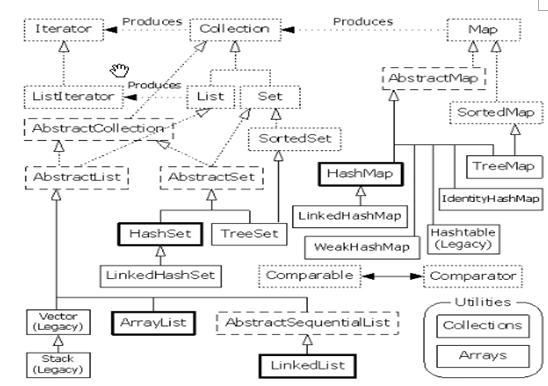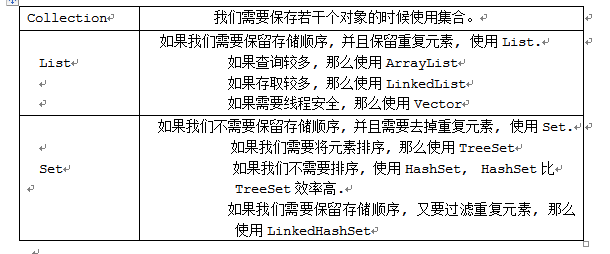java collection
1. What is a collection? A container for storing objects. Object-oriented languages embody things in the form of objects. Therefore, in order to facilitate the operation of multiple objects and store objects, collections are the most commonly used way to store objects. .
The appearance of collections is to hold objects. Collections can store objects of any type and have variable length. In the program, it may not be possible to know in advance how many objects are needed, so if an array is used to hold the objects, the length is difficult to define, and collections solve this problem.
2. The difference between sets and arrays
Arrays and collection classes are both containers
The length of arrays is fixed, and the length of collections is variable. Basic data types can be stored in arrays, and collections can only store objects. The data type stored in arrays is single, and objects of any type can be stored in collections.
Features of the collection class
are used to store objects, the length is variable, and different types of objects can be stored.
2.1. Disadvantages of arrays
A data container with a single storage type, complex operations (an array is immutable once declared) CRUD
1.3. Classification of collections
What collections do
1: Add objects To the collection
2: Delete the object from the collection
3: Find an object from the collection
4: Modify an object from the collection by adding, deleting, modifying and checking
Note: Collections and arrays store references to objects Rather than the object itself, Java engineers define different containers. Although the containers are different, there are still some commonalities that can be extracted. Finally, a top-level interface is extracted, and a collection framework is formed. How to learn? Of course, start from the top level, which contains the most common and basic behaviors. For specific use, you must choose a specific container. Why? Because the things that are constantly extracted may not be able to create objects. The possibility of abstraction is very high, and there are more methods for subclass objects. So look at the top layer and create the bottom layer. So what is the top level of the collection? It’s called Collection
Collection framework system
Collection: Single column collection List: Storage order, repeatable
List: Storage order, repeatable
ArrayList: Array implementation, fast search, slow addition and deletion
out Out Through Out Implementation, when adding and deleting, will involve increasing the capacity of the array and copying elements. So it is slow. Arrays can be searched directly by index, so the search is faster
LinkedList: Linked List: ’ s ’ s ’ s ’ ‐ ‐ ‐ ‐ out out of
Just do it yourself, delete it When the previous element remembers the next element, and the latter element remembers the previous element. This kind of addition and deletion efficiency is higher, but the query needs to traverse one by one, so the efficiency is low Vector : Same principle as ArrayList, but thread-safe, slightly lower efficiency ’ s ’ ’ s ’ ’ s ’ s ’ s ’ s 1 t onto out out out out through ’ through HashSet TreeSet - ’ ’ s ‐ ‐ out‐‐through ‐ t d to HashMaps Treemap Hashtable Linkedhashmap Why does so many sets of containers appear because each container storage method is different, this storage method is called data structure Pay attention to the collection and array of collection and array All stored in are references to objects. 4. When to use what kind of collection

Hot AI Tools

Undresser.AI Undress
AI-powered app for creating realistic nude photos

AI Clothes Remover
Online AI tool for removing clothes from photos.

Undress AI Tool
Undress images for free

Clothoff.io
AI clothes remover

AI Hentai Generator
Generate AI Hentai for free.

Hot Article

Hot Tools

Notepad++7.3.1
Easy-to-use and free code editor

SublimeText3 Chinese version
Chinese version, very easy to use

Zend Studio 13.0.1
Powerful PHP integrated development environment

Dreamweaver CS6
Visual web development tools

SublimeText3 Mac version
God-level code editing software (SublimeText3)

Hot Topics
 Square Root in Java
Aug 30, 2024 pm 04:26 PM
Square Root in Java
Aug 30, 2024 pm 04:26 PM
Guide to Square Root in Java. Here we discuss how Square Root works in Java with example and its code implementation respectively.
 Perfect Number in Java
Aug 30, 2024 pm 04:28 PM
Perfect Number in Java
Aug 30, 2024 pm 04:28 PM
Guide to Perfect Number in Java. Here we discuss the Definition, How to check Perfect number in Java?, examples with code implementation.
 Random Number Generator in Java
Aug 30, 2024 pm 04:27 PM
Random Number Generator in Java
Aug 30, 2024 pm 04:27 PM
Guide to Random Number Generator in Java. Here we discuss Functions in Java with examples and two different Generators with ther examples.
 Armstrong Number in Java
Aug 30, 2024 pm 04:26 PM
Armstrong Number in Java
Aug 30, 2024 pm 04:26 PM
Guide to the Armstrong Number in Java. Here we discuss an introduction to Armstrong's number in java along with some of the code.
 Weka in Java
Aug 30, 2024 pm 04:28 PM
Weka in Java
Aug 30, 2024 pm 04:28 PM
Guide to Weka in Java. Here we discuss the Introduction, how to use weka java, the type of platform, and advantages with examples.
 Smith Number in Java
Aug 30, 2024 pm 04:28 PM
Smith Number in Java
Aug 30, 2024 pm 04:28 PM
Guide to Smith Number in Java. Here we discuss the Definition, How to check smith number in Java? example with code implementation.
 Java Spring Interview Questions
Aug 30, 2024 pm 04:29 PM
Java Spring Interview Questions
Aug 30, 2024 pm 04:29 PM
In this article, we have kept the most asked Java Spring Interview Questions with their detailed answers. So that you can crack the interview.
 Break or return from Java 8 stream forEach?
Feb 07, 2025 pm 12:09 PM
Break or return from Java 8 stream forEach?
Feb 07, 2025 pm 12:09 PM
Java 8 introduces the Stream API, providing a powerful and expressive way to process data collections. However, a common question when using Stream is: How to break or return from a forEach operation? Traditional loops allow for early interruption or return, but Stream's forEach method does not directly support this method. This article will explain the reasons and explore alternative methods for implementing premature termination in Stream processing systems. Further reading: Java Stream API improvements Understand Stream forEach The forEach method is a terminal operation that performs one operation on each element in the Stream. Its design intention is






